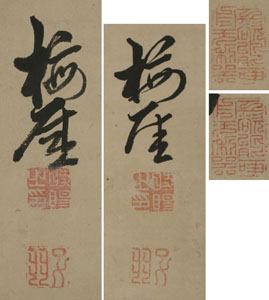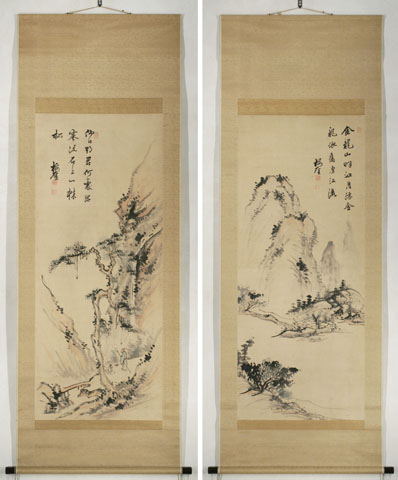Nanga
Two landscapes, one with scholarsSigned: Baigai
Seals: Toki Shi noin, Shiu
Technique: sumi and little colour on paper 135 x 56
Date: ca. 1802
Mounting: light bronze damask 203 x 72,5
Box: inscribed
Condition: very good
With a slip of ‘authenticity’ of the Kyoto National Museum April 16, 2004
The poetry reads:
[Right:]金龍山畔江月浮,金龍依旧湧江流
Along the border of the Golden Dragon Mountain, the moon floats on the river
The Golden Dragon uses an old well to make the river flow.
The first line is taken fro a Chinese poem by Hatori Nankaku (1683-1759):
[Links:] 他日期君何处好,寒流石上一株松。
When will we meet eachother again in the future: What would be an appropriate place,
Down there near the cold water at the lonely pine on the rocks.
Baigai became an important Nanga artist. He was born in Osaka where he received a first class education. The former Ôbaku monk Chô Tôsai (1712-1786) introduced Baigai to the Bunjin world. Without money he went to Kyoto where he worked in the pleasure quarters of Gion as an entertainer and comic. On his way to Edo he met with Masuyama Sessai (1754-1819 an enthusiastic patron of the bunjin movement, who awarded Baigai in 1783 with the post of Confucian scholar in his Edo residence. With Haruki Nanko (1759-1839) Baigai travelled to Nagasaki in 1790 to study Chinese classics, calligraphy and painting and resigned from his post with Sessai. As an eccentric bunjin now he went back to Osaka where he joined the group around Kimura Kenkadô (1736-1802) and started a Confucian training school.
Reference:
Roberts p. 7
Araki p. 1748
Rosenfield B.98 (# 166)
Adams & Berry p. 52 (# 15)
Addiss '75 p. 38 (# 15)
Beerens p. 154
Price: ON REQUEST

